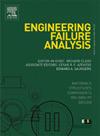Partial damage to the hall during a heavy rainfall
IF 4.4
2区 工程技术
Q1 ENGINEERING, MECHANICAL
引用次数: 0
Abstract
Among numerous causes of failures of large-format facilities, the loads caused by weather phenomena count among most frequent. Failures are typically caused by snow or wind load, while damage due to rainstorm is rarer. The study shows one such case when, after around 6 months of operation, part of the large-area roof of a production and storage hall collapsed. The failure occurred after 13 min of heavy rainstorm; however, the conducted analysis showed that the rain volume was within the ranges specified by the relevant standards. A detailed analysis was conducted of the design assumptions, structural calculations and the original design documentation, showing a number of design and construction errors, the effects of which compounded. The most critical error was the underestimation of the water load on the exterior sections of the roof, combined with too high roof attic and the absence of overflow scuppers. The result was a gradual failure involving the profiled sheet deck sections, followed by exterior purlins and expansion joint purlins, and some reinforced concrete columns. The study provides a detailed description of the failure, presenting the results of the authors’ own structural calculations and specifying the design and construction errors. The sequence of events of the failure is also reconstructed. Finally, the proposed recommendation are outlined.
求助全文
约1分钟内获得全文
求助全文
来源期刊

Engineering Failure Analysis
工程技术-材料科学:表征与测试
CiteScore
7.70
自引率
20.00%
发文量
956
审稿时长
47 days
期刊介绍:
Engineering Failure Analysis publishes research papers describing the analysis of engineering failures and related studies.
Papers relating to the structure, properties and behaviour of engineering materials are encouraged, particularly those which also involve the detailed application of materials parameters to problems in engineering structures, components and design. In addition to the area of materials engineering, the interacting fields of mechanical, manufacturing, aeronautical, civil, chemical, corrosion and design engineering are considered relevant. Activity should be directed at analysing engineering failures and carrying out research to help reduce the incidences of failures and to extend the operating horizons of engineering materials.
Emphasis is placed on the mechanical properties of materials and their behaviour when influenced by structure, process and environment. Metallic, polymeric, ceramic and natural materials are all included and the application of these materials to real engineering situations should be emphasised. The use of a case-study based approach is also encouraged.
Engineering Failure Analysis provides essential reference material and critical feedback into the design process thereby contributing to the prevention of engineering failures in the future. All submissions will be subject to peer review from leading experts in the field.
 求助内容:
求助内容: 应助结果提醒方式:
应助结果提醒方式:


